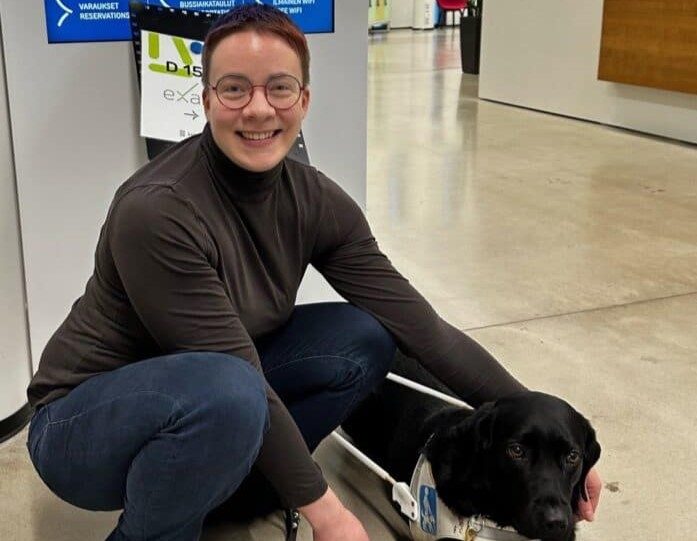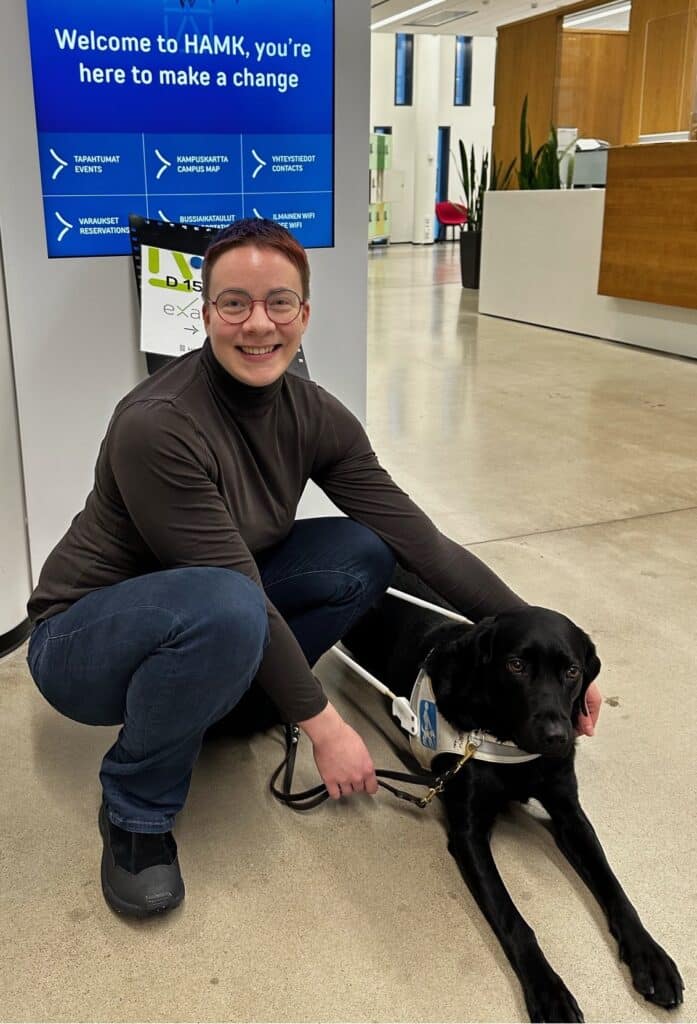We are all different

Ida Mauko is studying to become a Bachelor of Social Services at HAMK. Due to her visual impairment, she walks on the campus with a guide dog.
“I have a disease that degenerates my retina and narrows my field of vision. Retinitis pigmentosa causes me to see things as if through a tube. When the field of view of a person with normal vision is 180 degrees, I have about five left in the middle. Therefore, I don’t, for example, see a person’s face entirely, but an area about the size of an eye at a time. Same with texts: I see a letter or two at a time. For this reason, it takes much longer for me to read than for a fellow student who scans whole words or sentences. On top of this, I suffer from night blindness and light sensitivity at the same time – that’s also possible, Ida laughs.
Ida started her studies this autumn. “I’m a career changer. I used to work as a masseuse, but I wouldn’t have been able to continue doing such physical work. Studies in social services were exactly what I wanted: meeting people and helping them.
Individual arrangements and assistive technologies enable studying
There have been no major challenges in studies for Ida. “I was given extra time to take the entrance exam. Getting the materials from the teachers in advance helps me to study: this way I can read them in the time it takes me.”
Information technology helps Ida in her everyday life. Ida has adjusted her laptop to serve herself: the font size is large, and the inverted colors – i.e. white text on a black background – provide exactly the contrast needed for Ida’s vision.
“Visual impairments are different. Not everyone uses a screen reader, even though it is an absolute requirement for many blind people. In my previous studies, there were three of us visually impaired people in the same group, each with different visual impairments and different assistive technologies.
Ida has worked as an expert by experience in her own study group and told her fellow students what everyday life looks like for her. However, she emphasizes that she is only an expert in her own visual impairment. Ida thanks her fellow students for their open attitude and learning together.
Physical accessibility is important
Walking around campus has become easier by time. “When I come to a completely new place for the first time, I try to get someone to be eyes for me, even if I’ve looked at the guide maps beforehand. I use a map service a lot, and I get directions based on coordinates. It would be important to pin the location of the main door on maps. Or if there was a sound on the door as in traffic lights, it would be easier to find.
The main doors of the University Centre are being converted to open automatically. This is good news for Ida.
Indoors, Ida finds sufficient contrasts important. This applies to doors as well as signage. “If the door is exactly the same color as the wall, it’s hard for me to spot it. If the signage, e.g. room number or toilet sign, is minimalist or bordering the ceiling, I may not notice it. I have sometimes searched for a disabled toilet by looking for a lock on the door when I haven’t found a signpost! For me, glass doors are tricky, and so is finding a tint-to-tone handle on them. A sticker on the back of the handle would be helpful in this detection.
See the person
Accessibility means that as many people as possible are able to act as independently as possible despite possible limitations. These can be related to vision, hearing, motor skills, cognition… There is as much variety as there are people. Limitations can be permanent, such as Ida’s eye disease. They can also be temporary (eye infection) or situational (poor lighting). In different situations, the actions are also different.
“A person walking with a stick or dog does not necessarily need help in every situation, and in Finland people’s independence is well respected. If the person is clearly confused, it is worth asking if you can help. In such a situation, I myself ask for help very eagerly. If there is a potential danger, it must of course be addressed, Ida instructs.
And then there’s the hard part: a guide dog is at work and needs to be ignored. The important thing for us all is to face the person.
